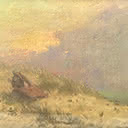Sophia
23.5 x 19 cm
est. $120,000 - 160,000
PROVENANCE Gifted to Charles Hunter Carson by Charles Goldie. Charles Carson sold Goldie his paints (he possibly worked at Philips & Impey). The artist and Carson had a long lasting friendship.
Charles Hunter Carson was born in Otahuhu in 1886 and was the son of David and Margaret Carson. Charles gave the drawing to his nephew, the current owners Grandfather William Hunter Carson Morrin (William was the son of Charles' sister Mildred who married Vince Morrin). The drawing was then handed down to Annette Galloway (nee Morrin) his eldest daughter. Then by descent. It was held in a draw for much of it's existence and was only framed recently.
Guide Sophia Hinerangi was the principal tourist guide of the Pink and White Terraces at Lake Rotomahana. Following their destruction during the Mt Tarawera eruption of 1886 she became a guide at nearby Whakarewarewa, Rotorua. Guide Sophie, as she was widely known, was well educated and bi-lingual. She introduced thousands of visitors to the beauty of the Terraces, acknowledged by Mark Twain as the eighth wonder of the world.
Sophia was born in Russell in the early 1830s. Her mother, Kotiro Hinerangi, was a Ngati Ruanui woman who had possibly been captured by a Nga Puhi raiding party. Kotiro married Alexander Grey (or Gray), a Scotsman who had arrived in the Bay of Islands in 1827. Mary Sophia Gray was baptised by William Williams at Kororareka in 1839.
It is thought that Sophia was raised by Charlotte Kemp at the Kerikeri Mission Station before attending the Wesleyan Native Institution at Three Kings, Auckland. In 1851 Sophia married her first husband, Koroneho (Colenso) Tehakiroe, with whom she had fourteen children. Following her second marriage, to Hori Taiawhio in 1870, she had a further three children. Tuhourangi Tohunga, interpreted the devastating Tarawera eruption as a warning and reflected that the exploitation of the terraces as a tourist attraction showed scant regard for ancestral values.
Sophia herself saw these omens as a sign that her time as a guide at Rotomahana was drawing to a close. On 10 June 1886, the night of the eruption, over sixty people took shelter in Sophia's whare at Te Wairoa. Unlike many of the buildings in the village her home withstood the power of the eruption due to its high-pitched roof and reinforced timber walls. Sophia continued her work as a guide when she moved to nearby Whakarewarewa.
In 1895 she joined George Leitch's Land of the Moa Dramatic Company, playing herself on a tour of Australia. In 1896 she was appointed caretaker of the Whakarewarewa Thermal Reserve. A number of royal parties were amongst the many thousands of visitors that Guide Sophia led through Whakarewarewa. She encouraged a number of local women to become guides, helping to establish this occupation as a rewarding form of employment for Tuhourangi women.
Remembered as a leading light of her generation and a unique personality of that time, Sophia fostered friendship between Maori and Pakeha and showed great courage in adversity. She was a friend and favoured subject the artist C F Goldie. Guide Sophia died at Whakarewarewa on 4 December 1911 among the Rotorua elders.
TWO DRAWINGS OF GUIDE SOPHIA BY CF GOLDIE LOTS 55&56





